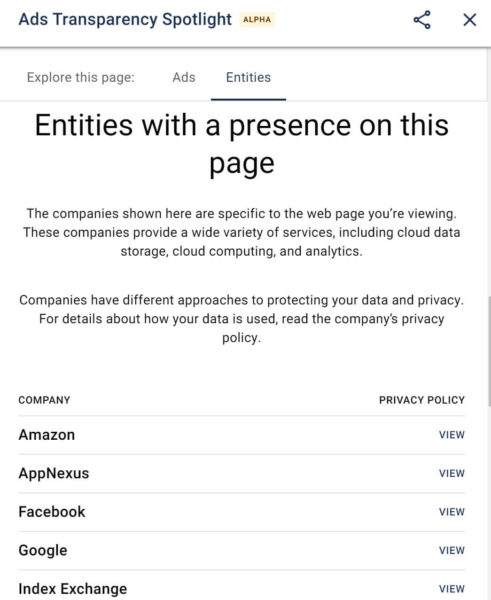Will Google’s Ad Disclosure schema catch on?
It's among several initiatives the company is working on as privacy takes center stage.
Google announced some updates to how it plans to inform users about the ads they see, including a new type of schema, as well as the latest on Privacy Sandbox proposals to manage ad serving, measurement and more without third-party cookies and cross-site tracking on Friday.
Ad Disclosure schema. Google’s testing an Ads Transparency Spotlight tool that relies on what it calls Ad Disclosure schema to show users information about the ads served on web pages.
The Ads Transparency Spotlight tool is available now as a Chrome extension in alpha stage. (You can also enable it in Microsoft’s Edge browser if you allow extensions from other stores.)
At this point the tool only shows data on ads purchased through Google Ads that have implemented Data Disclosure schema. Google’s hoping the schema catches on with other ad sellers. See this Github page for the types of data it can support.
The aim is to let users see “detailed information about all the ads they see on the web,” but it will need to get broad buy-in and implementation of Ad Disclosure schema to get there.
When the extension can’t detect any ads on a page, you’ll see this message: “Currently can only show information about display ads purchased through Google Ads. These ads have implemented a new Ad Disclosure Schema. As others implement the Ad Disclosure Schema into their ads’ HTML, they will appear here, too.”
If it does detect ads, at this point it simply lists the number of ads detected and the platforms used to buy them — currently just Google. The idea is to add information about why an ad was served. and include other controls in the tool.
An Entities tab lists all companies and services with a presence on the page — content delivery networks or analytics providers, etc.

About this ad. A new look for ad disclosures shown to users will be called “About this ad.” It will still continue to feature the “Why this ad” and “About the advertiser” sections. The verified advertiser information is pulled from your Ads account as part of the advertiser verification program that Google introduced for all advertisers in April.
The About this ad experience, shown below, will first start showing on display ads bought through Google Ads and Display & Video 360 in the coming months, followed by other ad formats in 2021.

Google says Why this ad receives more than 15 million user interactions daily and that it is now available when Google ads appear on connected TVs.
Privacy Sandbox update. Privacy Sandbox is the Chromium initiative for proposed alternative privacy-centric solutions for enabling advertising in ways that don’t rely on third-party cookies, device IDs or techniques like fingerprinting.
“One of the proposed APIs, for trust tokens that could combat ad fraud by distinguishing between bots and real users, is now available for testing by developers, and more will move to live testing soon,” wrote Mike Schulman,
vice president of ads privacy and Safety at Google, in the Friday’s blog post.
Safari and Mozilla already limit third-party cookies and Chrome is set to phase them out by 2022. This has significant implications for the entire ecosystem. In a guide for marketers published this month, Google says suggests brands focus on building direct (i.e. first-party) relationships with users and learn to be flexible with targeting and measurement “when personalization is limited.”
For more on where ad privacy is heading and how to prepare, read:
Contributing authors are invited to create content for Search Engine Land and are chosen for their expertise and contribution to the search community. Our contributors work under the oversight of the editorial staff and contributions are checked for quality and relevance to our readers. The opinions they express are their own.
Related stories